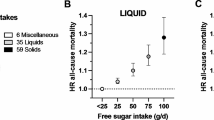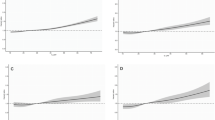Abstract
Purpose
A high intake of whole grains has been associated with a lower incidence of colorectal cancer, but few studies are available on the association with whole grains from different cereals, for example, wheat, rye and oats, and none has addressed these separately. The objective of this study was to investigate the association between whole-grain intake and colorectal cancer.
Method
We used data from the large population-based Scandinavian cohort HELGA consisting of 108,000 Danish, Swedish, and Norwegian persons, of whom 1,123 developed colorectal cancer during a median of 11 years of follow-up. Detailed information on daily intake of whole-grain products, including whole-grain bread, crispbread, and breakfast cereals, was available, and intakes of total whole grains and specific whole-grain species (wheat, rye, and oats) were estimated. Associations between these whole-grain variables and the incidence of colorectal cancer were investigated using Cox proportional hazards models. Intake of whole-grain products was associated with a lower incidence of colorectal cancer per 50-g increment (incidence rate ratio [IRR], 0.94; 95 % confidence interval [CI], 0.89, 0.99), and the same tendency was found for total whole-grain intake (IRR pr. 25-g increment, 0.94; 95 % CI, 0.88, 1.01). Intake of whole-grain wheat was associated with a lower incidence of colorectal cancer (IRR for highest versus lowest quartile of intake, 0.66; 95 % CI, 0.51, 0.85), but no statistical significant linear trend was observed (p for trend: 0.18). No significant association was found for whole-grain rye or oats.
Conclusion
Whole-grain intake was associated with a lower incidence of colorectal cancer.

Similar content being viewed by others
References
Ferlay J, Shin HR, Bray F, Forman D, Mathers C, Parkin DM (2010) Estimates of worldwide burden of cancer in 2008: GLOBOCAN 2008. Int J Cancer 127:2893–2917
Slavin J (2003) Why whole grains are protective: biological mechanisms. Proc Nutr Soc 62(1):129–134
Fardet A (2010) New hypotheses for the health-protective mechanisms of whole-grain cereals: what is beyond fibre? Nutr Res Rev 23:65–134
Slavin J (2004) Whole grains and human health. Nutr Res Rev 17(1):99–110
Aune D, Chan DS, Lau R, Vieira R, Greenwood DC, Kampman E et al (2011) Dietary fibre, whole grains, and risk of colorectal cancer: systematic review and dose-response meta-analysis of prospective studies. BMJ 343:d6617
Koh-Banerjee P, Franz M, Sampson L, Liu S, Jacobs DR Jr, Spiegelman D et al (2004) Changes in whole-grain, bran, and cereal fiber consumption in relation to 8-y weight gain among men. Am J Clin Nutr 80(5):1237–1245
Kyro C, Skeie G, Dragsted LO, Christensen J, Overvad K, Hallmans G et al (2012) Intake of whole grain in Scandinavia: intake, sources and compliance with new national recommendations. Scand J Public Health 40(1):76–84
Andreasen MF, Christensen LP, Meyer AS, Hansen A (2000) Content of phenolic acids and ferulic acid dehydrodimers in 17 rye (Secale cereale L.) varieties. J Agric Food Chem 48(7):2837–2842
Kumar V, Sinha AK, Makkar HP, de Boecker G, Becker K (2012) Dietary roles of non-starch polysaccharides in human nutrition: a review. Crit Rev Food Sci Nutr 52(10):899–935
Gonzalez CA (2006) The European prospective investigation into cancer and nutrition (EPIC). Public Health Nutr 9(1A):124–126
Lund E, Dumeaux V, Braaten T, Hjartaker A, Engeset D, Skeie G et al (2008) Cohort profile: the Norwegian women and cancer study–NOWAC–Kvinner og kreft. Int J Epidemiol 37(1):36–41
Hallmans G, Agren A, Johansson G, Johansson A, Stegmayr B, Jansson JH et al (2003) Cardiovascular disease and diabetes in the Northern Sweden health and disease study cohort—evaluation of risk factors and their interactions. Scand J Public Health Suppl 61:18–24
Van Guelpen B, Hultdin J, Johansson I, Stegmayr B, Hallmans G, Nilsson TK et al (2005) Folate, vitamin B12, and risk of ischemic and hemorrhagic stroke: a prospective, nested case-referent study of plasma concentrations and dietary intake. Stroke 36(7):1426–1431
Weinehall L, Hallgren CG, Westman G, Janlert U, Wall S (1998) Reduction of selection bias in primary prevention of cardiovascular disease through involvement of primary health care. Scand J Prim Health Care 16(3):171–176
Tjonneland A, Olsen A, Boll K, Stripp C, Christensen J, Engholm G et al (2007) Study design, exposure variables, and socioeconomic determinants of participation in diet, cancer and health: a population-based prospective cohort study of 57,053 men and women in Denmark. Scand J Public Health 35(4):432–441
Hjartaker A, Andersen LF, Lund E (2007) Comparison of diet measures from a food-frequency questionnaire with measures from repeated 24-hour dietary recalls. The Norwegian women and cancer study. Public Health Nutr 10(10):1094–1103
Overvad K, Tjonneland A, Haraldsdottir J, Ewertz M, Jensen OM (1991) Development of a semiquantitative food frequency questionnaire to assess food, energy and nutrient intake in Denmark. Int J Epidemiol 20(4):900–905
Tjonneland A, Overvad K, Haraldsdottir J, Bang S, Ewertz M, Jensen OM (1991) Validation of a semiquantitative food frequency questionnaire developed in Denmark. Int J Epidemiol 20(4):906–912
American Association of Cereal Chemists (2008) Definition of Whole Grain. http://www.aaccnet.org/INITIATIVES/DEFINITIONS/Pages/WholeGrain.aspx (accessed December 2012). Ref Type: Internet Communication
Slimani N, Kaaks R, Ferrari P, Casagrande C, Clavel-Chapelon F, Lotze G et al (2002) European prospective investigation into cancer and nutrition (EPIC) calibration study: rationale, design and population characteristics. Public Health Nutr 5(6B):1125–1145
DTU Food—The National Food Institute (Denmark) (2008) Fuldkorn—Definition og vidensgrundlag for anbefaling af fuldkornsindtag i Danmark (Wholegrain—Definition and scientific background for recommendations); available at: http://www.fuldkorn.dk/files/Rapporter/Fuldkorn%20definition%20og%20vidensgrundlag.pdf; (assessed June, 2010)
Kyro C, Skeie G, Dragsted LO, Christensen J, Overvad K, Hallmans G et al (2011) Intake of whole grains in Scandinavia is associated with healthy lifestyle, socio-economic and dietary factors. Public Health Nutr 14(10):1787–1795
Greenland S (1995) Avoiding power loss associated with categorization and ordinal scores in dose-response and trend analysis. Epidemiology 6(4):450–454
Greenland S (1995) Dose-response and trend analysis in epidemiology: alternatives to categorical analysis. Epidemiology 6(4):356–365
Andersen PK, Borgan O, Keiding N (1993) Regression models. In: statistical Models Based on Counting Processes, Springer p 495–496
World Cancer Research Fund/American Institute for Cancer Research (2011) Continuous update project interim report summary. Food, nutrition, physical activity, and the Prevention of Colorectal Cancer, available at: http://www.wcrf.org/PDFs/Colorectal-cancer-CUP-report-2010.pdf (accessed October, 2011)
Johnsen NF, Christensen J, Thomsen BL, Olsen A, Loft S, Overvad K et al (2006) Physical activity and risk of colon cancer in a cohort of Danish middle-aged men and women. Eur J Epidemiol 21(12):877–884
Bingham S (2006) The fibre-folate debate in colo-rectal cancer. Proc Nutr Soc 65(1):19–23
Egeberg R, Olsen A, Loft S, Christensen J, Johnsen NF, Overvad K et al (2010) Intake of wholegrain products and risk of colorectal cancers in the diet, cancer and health cohort study. Br J Cancer 103(5):730–734
Hansen L, Skeie G, Landberg R, Lund E, Palmqvist R, Johansson I et al (2012) Intake of dietary fiber, especially from cereal foods, is associated with lower incidence of colon cancer in the HELGA cohort. Int J Cancer 131(2):469–478
McIntyre A, Gibson PR, Young GP (1993) Butyrate production from dietary fibre and protection against large bowel cancer in a rat model. Gut 34(3):386–391
Topping D (2007) Cereal complex carbohydrates and their contribution to human health. J Cereal Sci 46:220–229
Zhu Y, Conklin DR, Chen H, Wang L, Sang S (2011) 5-alk(en)ylresorcinols as the major active components in wheat bran inhibit human colon cancer cell growth. Bioorg Med Chem 19(13):3973–3982
Acknowledgments
This study was supported by NordForsk (Centre of Excellence programme HELGA (070015)) and the Danish Cancer Society. The authors acknowledge data manager Knut Hansen for assistance with data preparation and project coordinator Jytte Fogh Larsen for administrative assistance.
Conflict of interest
The authors declare no conflicts of interest.
Author information
Authors and Affiliations
Corresponding author
Electronic supplementary material
Below is the link to the electronic supplementary material.
Rights and permissions
About this article
Cite this article
Kyrø, C., Skeie, G., Loft, S. et al. Intake of whole grains from different cereal and food sources and incidence of colorectal cancer in the Scandinavian HELGA cohort. Cancer Causes Control 24, 1363–1374 (2013). https://doi.org/10.1007/s10552-013-0215-z
Received:
Accepted:
Published:
Issue Date:
DOI: https://doi.org/10.1007/s10552-013-0215-z




